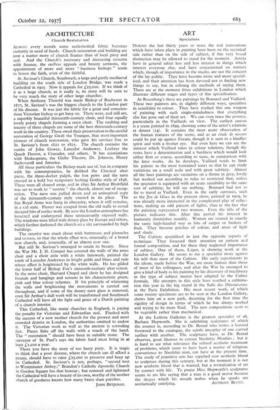ART
Specialists
DURING the last thirty years or more the real innovations which have taken place in painting have been on the technical side rather than on the side of subject, if this very broad distinction may be allowed to stand for the moment. Artists have in general taken less and less interest in things which interest everyone else, and have concentrated on matters which, though of importance in the studio, are not the concern of the lay public. They have become more and more special- ised, and their attention has been devoted not to finding new things to say, but in refining the methods of saying them. There are at the moment three exhibitions in London which illustrate different stages and types of this specialisation.
At Rosenberg's there are paintings by Bonnard and Vuillard. These two painters arc, in slightly different ways, specialists in sensibility to colour. They have studied this one weapon of painting with such single-mindedness that everything else has gone out of their art. We can even trace the process, particularly in the Vuillards on view. The earliest canvas is a scene painted in 1899, showing some of the artist's relations at dinner (4). It contains the most acute observation of the human features of the scene, and as an etude de moeurs could be put up against Forain, though it is seen_ in a kindlier spirit and with a fresher eye. But even here we can see the interest which Vuillard takes in colour relations, though the notes have a determination and a hardness which would look either firm or coarse, according to taste, in comparison with the later works. As he develops, Vuillard tends to limit his palette to the most restrained tones so that he can study variations on a small scale and with great subtlety. Almost all the later paintings are variations on a theme in grey, lovely but worked out according to rules so restricted that, unless the spectator is equipped with an acute sensibility to the same sort of subtlety, he will see nothing. Bonnard had not so far to travel as Vuillard. Even in the early canvases, such as the jai de Glace in the present show, painted in 1909, he was already more interested in the complicated play of reflec- tions, making an odd pattern of lights, than in the fact that the painting represented two women. Even the title of the picture indicates this. After this period his interest in humanity diminishes steadily. Women are treated in exactly the same high-handed way as bits of carpet or baskets of fruit. They become patches of colour, and areas of light and shade.
The Cubists specialised in just the opposite aspects of technique. They focussed their attention on pattern and formal composition, and for these they neglected importance of subject. One of them, Leger, is showing work at the London Gallery. He seems to me a specialist more against his will than most of the Cubists. His early experiments in the idiom, made before the War, are more human than those of most of his colleagues, and after the War he managed to give a kind of body to his painting by his discovery of machinery as the type of subject matter best adapted to the Cubist formula. His attempts in this style have reached a culmina- tion this year in the big mural in the Salle des Decouvertes at the Paris Exhibition. His most recent work, of which some twenty specimens are to be seen at the London Gallery, shows him on a new path, deserting for the first time the rigidity of design in terms of which he has always worked and trying to be more fluid. The new compositions seem to be vegetable rather than mechanical.
At the Lefevre Galleries is the greatest specialist of all, Barbara Hepworth. She is exhibiting sculptures of which the essence is, according to Dr. Bernal who writes a learned foreword to the catalogue, the subtle interplay of one curved surface with another. The sculptures have, as Dr. Bernal observes, great likeness to certain Neolithic Menhirs ; but it is hard to see what relevance the refined aesthetic treatment of problems, which seem to have been a matter of religious convenience to Neolithic man, can have at the present time. The study of primitive arts has supplied new aesthetic blood to sculpture during this century, but at the moment it is not new aesthetic blood that is wanted, but a revitalisation of art by contact with life. To praise Miss Hepworth's sculptures seems to me like saying that a man is a good orator because the shapes which his mouth makes when he speaks are






























































 Previous page
Previous page